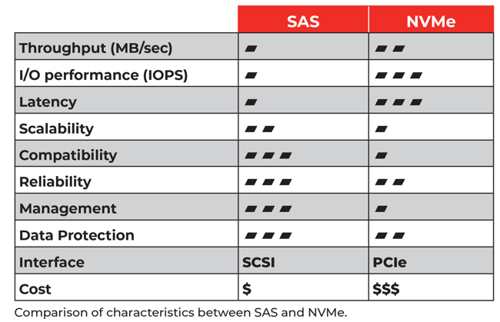From Atto Technology: Choosing Between SAS and NVMe for Data Center
Customers are still using SAS for capacity and NVMe for performance, working together, it’s possible to develop cost-effective storage architecture.
This is a Press Release edited by StorageNewsletter.com on April 6, 2023 at 2:02 pmBy Peter Donnelly, director, marketing, Atto Technology, Inc.
When our customers ask whether SAS or NVMe is right for them, we recommend they look at their architecture needs holistically. In many cases it’s more involved than simply one technology being superior over another. Performance, cost, scalability and a host of other factors need to be considered to find the best fit and, sometimes, the ‘best’ solution is a combination of several technologies working together.
 Copy
Copy
Over the past few years the new kid on the storage block, NVMe, has been stepping into its own in data center applications. As our customers consider which storage technologies are best for their environments, we are often asked ‘which is better, NVMe or SAS ?’ Our answer is based on years of experience helping customers design the best storage solution for their particular needs and that is ‘…well, it depends.’
We recommend that customers look at their architecture needs holistically when deciding on what the right storage technology is for them. In many cases, it’s more involved than simply one technology being superior to another. Performance, cost, scalability and a host of other factors need to be considered to find the best fit and, sometimes, the ‘best’ solution is a combination of several technologies working together. Let’s take a look at some of the things we encourage our customers to consider.
SAS storage technology evolved from the tried-and-true SCSI protocol and is used across a variety of storage media, including HDDs, SSDs and tape. It was developed with the data center in mind, providing a balance of performance and cost while offering the highest levels of reliability and scalability. It uses SAS expanders as a cost-effective way to grow and manage extremely large (more than 64K devices) storage pools. Overall, SAS has been the uncontested choice for enterprise storage connectivity for almost 2 decades.
NVMe storage technology first gained traction as a solution for mobile devices as a boot or application drive. Its high performance made it perfect for ‘instant on’ consumer devices. Since then storage experts have worked to adapt NVMe technology for enterprise applications where support for extremely high I/O was needed for certain applications.
As users started to experiment with NVMe in applications where SAS was traditionally used, it quickly became obvious that switching to NVMe was not a simple plug-and-play operation. Attention needed to be paid to what characteristics were the most important or even non-negotiable requirements. Since Atto develops products for both SAS and NVMe technologies, our experience has been that there are a handful of vital characteristics that should be evaluated prior to our customers selecting which storage is right for them.
Throughput and I/O performance
Performance means different things to different people, depending on the applications they run. For instance, databases typically require fast access to small block, non-sequential data. On the other hand, many content creation applications are designed to access data in very large, sequential blocks. Latency requirements also need to be factored into the equation. NVMe drives outperform an equivalent SAS SSD drive in all of these areas, although it is most impressive in small block, random access applications.
One especially important reason why performance is so much better with NVMe is that it uses the PCIe interface to connect directly to the host processor rather than a SCSI interface like SAS technology does. As PCIe Gen4 and Gen5 appear in more systems, NVMe will continue to show dramatic performance improvements.
SAS technology is excellent but from a pure performance perspective (i.e. latency, IOs, throughput) NVMe storage is truly exceptional comparatively. NVMe is able to deliver up to 6x better throughput and IO/s performance than an equivalent SAS SSD with even better performance predicted in the near future.
Despite the tempting numbers captured in isolated speed tests, we should keep in mind context is everything and so we must look even deeper to unearth the entire story.
Scalability and compatibility
Since SAS is fundamentally ubiquitous and has been for nearly 2 decades, and SSDs have been SAS-compatible since appearing on the market, it’s understandable that there may be misconceptions about how to deploy NVMe storage. Therefore we think it’s important that customers clearly understand that bringing NVMe into the mix requires a separate, parallel infrastructure.
Although NVMe is loosely based on the SCSI standards there are substantial hardware differences that make SAS and NVMe devices completely incompatible. Additionally, the hardware layers and communication protocols differ substantially. Most software applications are optimized for SAS storage, so before moving to NVMe storage, we recommend to customers that they perform a thorough evaluation of their environments to ensure it is compatible and capable of working well with NVMe.
Furthermore, while SAS was based on a cost-effective and scalable expander architecture that supports extensive daisy-chaining, NVMe requires the use of switches to aggregate drives into larger storage pools. This adds cost and complexity to the architecture and makes it very difficult to scale outside the server box since NVMe is based on pure PCIe as the transport protocol. While technologies are on the horizon to make outside-the-box scalability a reality (i.e. NVMe-oF), these technologies will take several years to become standardized and widely available.
So, when it comes to scalability and compatibility, although this will change over time as architectures evolve, SAS has the clear edge here.
Reliability and management
One of the reasons that NVMe offers better performance than SAS technology is that the NVMe standards removed much of the management and error-correction capabilities from the software command set. So, it’s as if NVMe users are in a race car but the windshield is a bit opaque. SAS storage has an incredibly robust command set, built over decades of experience, that supports features like advanced error detection and correction, drive hot swapping, fault tolerance and data protection via hardware and software RAID.
Some of NVMe technology’s shortcomings can be overcome with 3rd-party tools like ATTOview, which provides a granular understanding of NVMe data movement and even offers an interface for in-band as well as out-of-band management. Generally speaking though, for users who depend on their storage for the highest levels of reliability, SAS is difficult to beat.
Cost
This is where the rubber meets the road, so to speak. As much as we’d all like to have the fastest storage on the market for everything from machine learning to managing our grocery lists, the reality is that we all need to make ROI decisions based on budgets and other demands. From a pure acquisition cost, the reality is that SAS storage costs less than a nickel/GB for a very good-performing platform. As far as bang for the buck goes, it’s hard to beat SAS storage – especially for archiving and cold storage where SAS tape costs less than $0.02/GB. NVMe storage can’t even come close to matching SAS on acquisition costs.
But ROI is about more than acquisition cost. How is the storage being used ? If the storage is being measured by the number of IO/s compared to the storage capacity (IOs/GB) or even cost per I/O ($/IO/s), then NVMe quickly becomes very cost-effective. To that end, we always recommend evaluating cost on an ROI and TCO basis to get a true measure of the value of a particular storage technology.

Overall, the choice between NVMe and SAS will depend on the specific needs of your application. If you require high-performance storage for demanding applications, NVMe may be the better choice. If you need a scalable, cost-effective solution that is compatible with legacy systems, SAS may be the better choice. The most important thing to do when deciding is to prioritize and quantify each of the characteristics so that you can make the best choice for your specific environment. Every decision is unique and, many times, what we find is that our customers are still using SAS for capacity and NVMe for performance. Working together, it’s possible to develop a very cost-effective storage architecture.














 Subscribe to our free daily newsletter
Subscribe to our free daily newsletter

